Discover War Memorials in Kenya

Brief Overview of War Memorial in Kenya
One way to honour the brave men and women who have paid the ultimate price for country – and to venerate in others who reap the benefit of the fallen – is to build memorials. That’s what many countries around the world have been doing since wars became commonplace, none more so than the two world wars. These transformed the very essence of humanity, and the specks of land where these were waged are museums of history that include ruins, and rather importantly war memorials. Paradigmatic shrines of stillness, at a time when the world is in turmoil about the fundamental values of democracy and prosperity. Around the world, war memorials are evocative of a light through a keyhole, that although the past is in the past, history rhymes. In Kenya, war memorials are maintained by the Commonwealth War Graves Commission (CWGC), which honours the 1.7 million men and women who died in the armed forces of the British Empire during the First and Second World Wars (in the Commonwealth nations), and ensures they will never be forgotten. “During the Second World War, Nairobi was the headquarters of the East African Force and the base for the conquest of Jubaland and Italian Somaliland, the liberation of British Somaliland and the forging on north-westward to open Addis Ababa for the return of the Emperor”.
“We have not seen and probably will never know the true level of sacrifice of our veterans. As a civilian I owe an unpayable debt to all our military. Going forward let’s not send our servicemen and women off to war or conflict zones unless it is overwhelmingly justifiable and on moral high ground. The men of WWI & WWII were the greatest generation. Every generation has proved itself to be worthy to stand up to the precedent of the greatest generation. Let’s all take a remembrance for all veterans who served or are serving, peace time or wartime and gone or still with us. May God bless our veterans. – Thomas Smith
1. Isiolo Memorial

Isiolo Memorial is situated at the junction of Isiolo Road and the lane leading to the District Commissioner’s Office. It commemorates 19 African soldiers who died during the 1939-1945 War, whose unmarked graves in Isiolo Cemetery (an African burial ground) are intermingled with civilian graves. 3 of them are not identified. The Memorial consists of a screen wall inset with panels of Portland stone on which are engraved the names of 16 African soldiers and 3 unknown African soldiers. The dedicatory panel reads: “The Soldiers who are honoured here gave their lives in the serice of their county and are buried in this District”.
2. Kajiado War Memorial

Hot and dusty but with a much improved road network, Kajiado Town – 77 kms from Nairobi – is the seat of Government for Kajiado County and the unofficial capital for the Maasai who are the dominant inhabitants. Its name (Kajiado) is derived from the Maasai idiom “Olkeju-ado”, translating to “the long stream”. Kajiado River cuts through the ridge southwest of Kajiado Town to drain the eastern side of the Lemillebbu Hills and the western side of the Ngoragaishi Hills. The importance of Olkejuado answers to the simple fact that no rivers flow perennially, and in the dry seasons water is obtained by digging in the bed of the Kajiado River. Excepting the low-lying encircling hills, much of the land around Kajiado Town is relatively flat, slopping westward towards the Turoka Valley and Rift Valley. One of the few places of interest in Kajiado Town is the Kajiado War Memorial. Begun in 1915 as the Kajiado Hospital Cemetery, it was renamed Kajiado War Memorial in 1916 after seven outlying WWI graves were brought into the cemetery, then containing 19 graves of soldiers who died in service between 1914-1921. It holds a total of 26 commonwealth graves set in an open ground behind the Kajiado Hospital (3 kms south of the railway terminal).
3. Kiambu (St. Paul) Churchyard Memorial
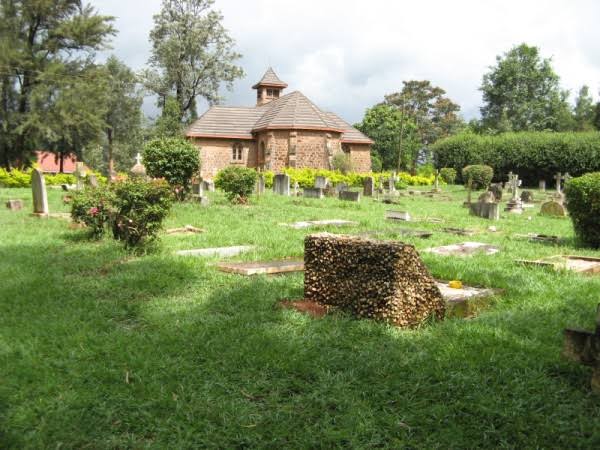
Kiambu Town is about 16 kms from Nairobi via Kiambu Road. St Paul’s Church is close to the Kiambu Institute of Science and Technology, and can be reached about 300 metres along the turn off to the right, signposted to Ruiru. The single private memorial to the Earl of Erroll is close to the hedge on the left hand side of the churchyard, under a Frangipani tree. Shortly after Kiambu Institute of Technology, downhill past the riverbend, take the earth feeder road on the right hand side and drive approximately 100 metres. The church gate is situated on the right hand side and on entry the graves will be found on the left hand side of the church. There are a number of civilian graves in rows. The Commonwealth war grave is in the second row and second from the hedge of the church. It is not marked by a Commission headstone, but by a permanent private memorial.
4. Thika War Memorial

The Thika War Cemetery contains 128 Commonwealth burials of the Second World War; four of which are unidentified plus two non-war burials. This park, found along the General Kago Road, is a moving landmark commemorating the dauntless and lion-hearted soldiers who paid the ultimate price. The somber Thika War Cemetery offers a historic connection to the past and is a formidable location to ponder on the intrinsic values of life. It’s located within Thika Town.
5. Kisii Boma Cemetery

This is a hundred yards from the Kisii Government Office and contains only one grave of Captain Edward Gerald Mytton Thorneycroft, the Adjutant of 4KAR. In 1914, he was placed in command, and his force consisted of ‘G’ Company 4KAR based at Kisumu, ‘C’ and ‘D’ Companies 4KAR from Masaka in Uganda, and 50 British East African police from Kisumu, as a British response to the German occupation of Kisii, who had advanced in numbers and sending as many troops as possible from Uganda across Lake Victoria to Kisumu and then on to Kendu, and eventually to Kisii. On the outbreak of the Great War, the energetic military commander in German East Africa (GEA), Colonel Paul von Lettow-Vorbeck, wasted little time in attacking both Nyasaland and British East Africa (BEA). “Four natural invasion routes were available from German territory into BEA and Schutztruppe troops used all of them. On the Indian Ocean coast a push on Mombasa was repulsed by the British at Gazi, whilst further to the north-west fierce fighting took place in the thick bush of the Tsavo River Valley. The more arid route to Kajiado and Nairobi from GEA via Namanga was used by mounted German raiding parties who clashed with detachments of the Magadi Defence Force and East Africa Mounted Rifles. Also an advance towards Kisumu – the railhead of Uganda Railway, was made along the southern area of Lake Victoria.
Captain Thorneycroft occupied a ridge of high ground overlooking Kisii town on the morning of September 12, 1914, and observed the enemy force parading and preparing to march towards Kisumu. However the Germans were soon alerted by local Africans that the British were occupying the ridgeline and a determined enemy attack was mounted. Thorneycroft then advanced with a party into Kisii town but he was soon surprised by a German patrol and shot dead. At sundown, both sides having suffered sizable casualties, Captain von Wulfingen, himself wounded, decided to abandon his attack. He left the wounded that he could not carry and quickly withdrew his survivors back directly towards the border and then across the Mara River in GEA. The next day, September 13, the British re-occupied the gutted Kisii to find 5 wounded Germans and 16 wounded enemy Askari lying on the ground, along with disused rifles, revolvers and supplies. A military garrison occupied Kisii and troops took stern measures to discipline the looters and to re-establish British East Africa government’s authority. The graves of the Germans who died at Kisii are in the CWGC cemetery at Kisumu. The burial sites of the dead local askaris of both sides are regrettably unknown
6. Kisumu Cemetery
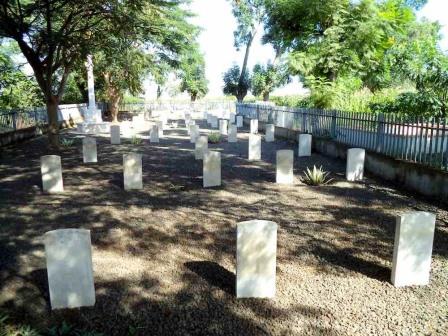
The Kisumu War Civil Cemetery situated within range of the B1 Kisumu-Busia Road holds the remains of 65 World War 1 and II war heroes – from 1915-1948. Among the remains contained here are those of 9 German soldiers brought in 1914. “This is a civil cemetery used for War burials (chiefly by the No.4 Base Hospital) from July 1915 up until September 1920. There are 9 Commonwealth burials of the 1914-1918 war, 4 were brought in after the Armistice, there are 9 German burials, all of the September 12th, 1914, which were brought from Kisii Boma. There are also 47 Commonwealth burials of the 1939-1945 war”. Kisumu War Cemetery is open Monday to Friday, from 06:00 am and 6:00 pm. It is found 500 ms past the exit to Kisumu Airport nearby Ministry of Works Depot.
A dedicatory panel reads: “As in the First World War, when the country was the base for the early stages of the campaign in German East Africa, Kenya became an important base in the Second World War – this time in operations across her northern frontier district for the conquest of Italian East Africa. Kenya was the assembly point for troops sent from other parts of the Commonwealth for the campaign, the site of base hospitals, convalescent centers and supply depots and, after the operations in Italian East Africa had been successfully concluded, the training ground for East African troops destined for other theatres. The Kenya battalions of the King’s African Rifles, which had fought with distinction in the First World War, were raised to many times their peace-time number and supporting arms and services were formed so that the East African brigades and divisions which subsequently took the field were complete and self-supporting. They took a full part in the campaigns in Madagascar and Burma, as well as in Italian East Africa, and their feats of arms will be remembered equally with those of the forces of other Commonwealth countries at whose sides they fought. All were volunteers and very many came from Kenya. African soldiers who lost their lives in battle are buried in the war cemeteries or commemorated on memorials in the campaign areas. Many who died in Kenya are buried in war cemeteries but others, whose graves are in places where they cannot be properly maintained are commemorated on the memorial in the Nairobi War Cemetery, which carries the names of 480 East African soldiers. The Kisumu War Civil Cemetery contains 18 burials of the First and 47 of the Second World War. By forces they comprise 30 South African, 24 British, 2 Australian, and 9 German”.
7. Kitui War Memorial

The traditional route to Kitui Town is along A3 Thika-Liboi Road to Kanyonyoo then south via B7 Kibwezi-Kitui Road, in sum traversing 131 kms. It sits on the western hilly area of Kitui County with higher rainfall that naturally support the densest native population. “The mango flourishes in groves nearby to Kitui, and tobacco is produced locally on a commercial scale. Deforestation as a result of shifting tribal cultivation is almost complete, but some of the higher ridges are capped by indigenous trees including podo, brown olive, mvuli, and the cape chestnut, and these have been supplemented by recent planting”. Kitui Town grew from a small colonial outpost set up to administer Kitui Native Reserve and colonial farmlands. Although it has a lengthy history of interaction with the British Empire and early Christian missionaries, most of its chronicles have been obliterated into history. The timeworn Kitui War Monument, found within Kitui County Offices, set up in honour of soldiers who fought in WW1, is a rare relic of Kitui’s rich history. The township has plenty of accommodation options.
8. Nanyuki War Cemetery
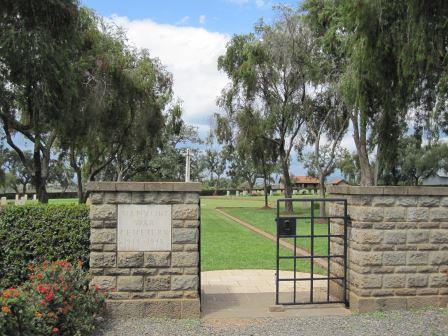
Nanyuki War Cemetery is found 4 kms along a rough road from the township, turning left onto the road into Mount Kenya Safari Club. The cemetery is down the roadway on the left hand side, set well back with the grassed entrance drive marked by boundary stones. The route is well signposted from town. During the Second World War, Nanyuki Town was the key rail head for the advance into Ethiopia, via Isiolo, Marsabit and Wajir, and was also an important advance base for the Royal Air Force. The war cemetery was started during hostilities by the Army, the first burial taking place in February 1940. In 2008 the nearby Civil Cemetery burials were transfered here. Today, the Nanyuki War Cemetery contains 196 Commonwealth burials of the Second World War. There are also 36 non-war burials and one Abyssinian war grave situated within the Cemetery.
9. Marsabit Cemetery
During the Second World War, Marsabit had several guard posts overlooking the “main route” between Kenya and Italian East Africa (Somalia). The small enclosure with a low fence located within Marsabit Cemetery commemorates 24 troops who died in the 1939 to 1945 wars nearby Marsabit which were but extensions of World War II. Marsabit Cemetery is found within Marsabit Town.
10. Mombasa (Mbaraki) Cemetery
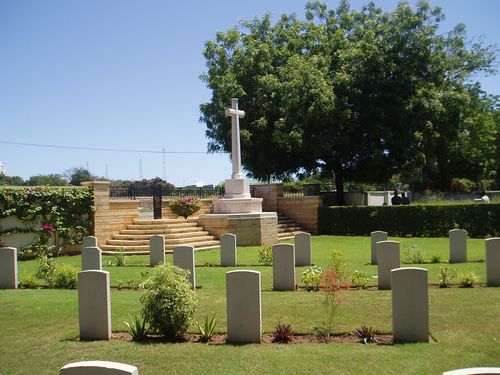
Mombasa (Mbaraki) Cemetery located on the southern side of the island along Mbaraki Road is a large civil cemetery which contains war graves plots as well as scattered war graves. The Cemetery fronts directly onto the road, from which the Cross of Sacrifice by the Second World War graves plot can easily be seen. The WWI graves are scattered on either side of the path running from north to south within the civil cemetery, either individually or in plots. “During the First World War, Mombasa was home to No.1 Base Hospital. Numerous wartime activities took place there during the Second World War and it was of some importance as a minor naval base. Mombasa (Mbaraki) Cemetery contains 51 Commonwealth burials of the First World War and 146 of the Second World War. There are also 28 non-war and two French war graves. The base of the Cross of Sacrifice in the cemetery forms the Mombasa British Memorial which records the names of 81 officers and men of the United Kingdom Corps and Regiments, of South, West and East African units and the West India Regiment, all of whom died during the First World War and were buried at sea off the East African coast” – CWGC. This cemetery is open daily between 06:00 and 18:00.
11. Mombasa (Mayimbo) War Cemetery
Mombasa (Mayimbo) War Cemetery is located in northern area of the island, in the area now known as Tudor, 3 kms before Nyali Bridge. At the junction where there is a pronounced bend on the road, turn right in front of Tudor Inn. Take the next turning left at the small roundabout and left again at the CWGC road direction sign. After about 100 metres turn right at the route confirmation sign. Mombasa (Manyimbo) War Cemetery is about 20 metres down this track on the left, and the Mombasa (Manyimbo) Roman Catholic Mission Cemetery will be found about 30 metres to the left of the War Cemetery. It is open daily between 06:00 and 18:00, but is locked at other times. Mombasa’s importance as a big trading hub owes its advantage to its natural deep water habour, the only one of its kind in East Africa, which also attracted conflict since medieval times. Three centuries after the Portuguese left the East Africa Coast Mombasa became the capital of British East Africa, while immediately south lay German East Africa (Tanzania). “During WWI the importance of defending Mombasa’s coast and the entrance to its ports again came to the forefront. Six naval guns from the British cruiser HMS Pegasus, which had sunk off Zanzibar in a German attack, were salvaged and restored, and one of these became the first gun position on Azania Drive (as Mama Ngina Drive was then called), at the site of present day Florida Club” – Hans-Martin Sommer. Numerous wartime activities took place in Mombasa during the Second World War and it was of some importance as a minor naval base. This civil cemetery holds 19 Commonwealth burials of WWII.
12. Mombasa African Memorial

Also known as African Memorial Park situated 2 kms east of Kraph Memorial Heritage Park off Nyali Road and Jomo Kenyatta Road, adjacent to Mombasa Academy, it commemorates the native and Arab soldiers who fought in the 1914 to 1918 wars. Redolent of the Statue War Memorial along Kenyatta Avenue in Nairobi, this is a solemn reminder of the brave fighters who bore arms “for King and for County”, as was the norm in this era. It embodies a ‘more recent era’ in Mombasa’s beguiling history that dates back to 900 AD, as a lighthouse centre. “At the outbreak of the First World War Tanzania was the core of German East Africa. From the invasion of 1915, Commonwealth forces fought a protracted and difficult campaign against a relatively small but highly skilled German force under the command of General von Lettow-Vorbeck. When the Germans finally surrendered on November 25, 1918, fourteen days after the European armistice, their numbers had been reduced to 155 European and 1,168 African troops. The African troops and followers who died with the Commonwealth forces during the East African campaign of WW One are for the most part commemorated by the triad of memorials, at Nairobi, at Mombasa and at Dar es Salaam – CWCG.
13. Muranga (St. James & All Martyrs) Churchyard
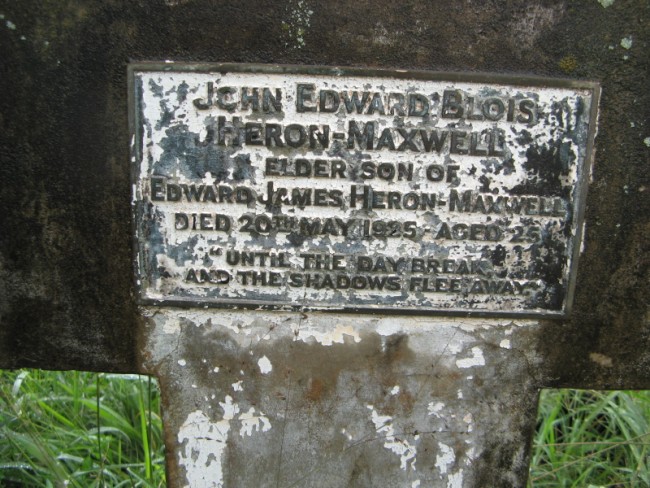
After pacification, the white settlers began to farm on land which was alienated from the Kikuyu. Resistance in Muranga was also weakened by collaborators such as Karuri Gakure and his chiefs like Karanja Njiiri who aided the settlers to establish their rule. Before the end of the First World War, the total amount of land in Muranga District was estimated to be 1,754 km2. This was divided up into 338 km2 of un-alienated land, 193 km2 of Forest Reserve, 257 km2 of farm area and 255 km2 of Native Reserve. Despite many failures, some settlers were able to progress. Swift and Rutherford had a factory in full working order and a large sisal estate in Thika. Sisal Limited erected a factory and increased their area under cultivation. Coffee estates were started by Cunningham and Trotter, Foncus, Elkington, and Gooch and Tayeer and Posho Limited put in a large area of beans and erected machinery for dealing with their crop. At Muranga (St. James & All Martyrs) Churchyard in Muranga Town, near Muranga Law Courts and a hundred yards South of Fort Hall Police Office, is a civil cemetery with the singular grave of John Edward Blois Heron Maxwell, who died at Fort Hall on May 20th, 1925, and the only recorded casualty and memorial from World War One in the area. The inscritopn on the headstone reads: John Edward Blois / HERON-MAXWELL / elder son of / Edward James HERON-MAXWELL / died 20th May 1925 aged 25 / “until the day breaks and the shadows flee away”.
Food for Thought
“Judged by all practical standards, the value of my mathematical life is nil; and outside mathematics it is trivial anyhow. I have just one chance of escaping a verdict of complete triviality, that I may be judged to have created something worth creating. And that I have created something is undeniable: the question is about its value. The case for my life, then, or for that of any one else who has been a mathematician in the same sense in which I have been one, is this: that I have added something to knowledge, and helped others to add more; and that these somethings have a value which differs in degree only, and not in kind, from that of the creations of the great mathematicians, or of any of the other artists, great or small, who have left some kind of memorial behind them.” G.H
